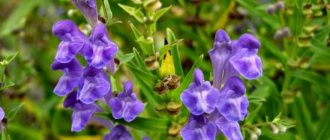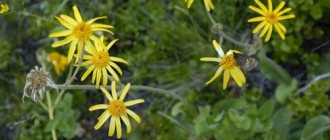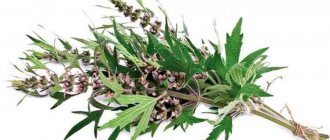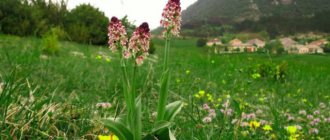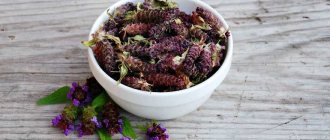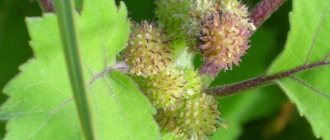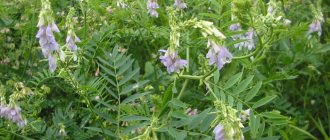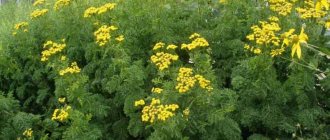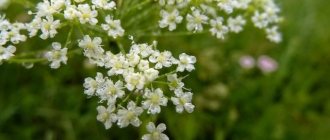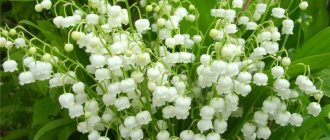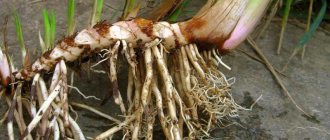Description of the plant
Edible or berry laccone is a herbaceous plant with woody branches reaching a height of 2 m, a fleshy rhizome weighing up to 10 kg and a dense spherical crown. It is unpretentious in care, winters quietly under the snow, and is able to recover even after the harshest winters. In the spring it rises very quickly, sometimes drowning out the growth of nearby plants. The bark of many commonweeds is reddish-purple or green. The berries appear closer to autumn.
What is useful for Lakonos: its medicinal properties and contraindications
Lakonos refers to flowering plants that have a tall and thick stem, reaching three meters in height, with leaves in the shape of an ellipse
.
The historical homeland of the plant is Latin America. Its flowering can be observed throughout the summer. The berries have a dark purple hue and are arranged vertically on the stems.
On the territory of our country, laccone can be found in botanical gardens and artificial flower beds. Preferred areas for this plant are the edges of roadways, garden plots among cultivated plants and areas of shrub plantings.
Places of growth
Lakonos grows in partial shade along roads and in residential areas in a variety of places. It can be found in Japan, India, Korea, China, Russia (Voronezh and Moscow regions, Mordovia), Europe. Sometimes this plant is confused with American phytolacca. The reason is simple: the only difference between them is the inflorescences; in Phytolacca Americana they are drooping. Laconaceous plants can be grown as ornamental plants, but they must be cared for carefully. If you touch their leaves without gloves, you can get burned worse than if you touch nettles.
Are puffweeds edible or poisonous?
Many gardeners who want to grow these unique plants in their garden plots are interested in whether it is possible to eat the berry plant, or rather, its fruits. But there is no simple answer to this question. Some experts say that the berries of the plant, which are so similar to raspberries, blackberries or mulberries, can be consumed in small quantities, but little by little and only for medicinal purposes. Others insist that it is not, and give a compelling argument: all parts of the lacquer plant are poisonous. So where is the truth?
In fact, both are right. Laconium berry plants are truly poisonous, this has been proven by scientists. But dangerous properties most often appear in those that grow in the wild. Cultivated herbs often completely lose their toxicity. Additionally, the toxic substances they contain are destroyed during heat treatment and fermentation. But this does not mean that they should be consumed in handfuls. To avoid poisoning, you should eat no more than 2-3 berries per day, and even then with caution. And remember: only the external use of decoctions and infusions created from the described plant does not cause any harm.
Against ulcers and kidney inflammation
In folk medicine, lakonos is used in recipes against stomach ulcers and inflammatory processes in the kidneys. With the consent of the attending physician, you can use alcohol tincture according to the following recipe:
- 10 grams of the rhizome of the plant is poured with 100 ml of alcohol with a strength of 70%.
- The mixture is poured into a jar and kept for ten days in the dark.
For treatment, you need to drink 25 drops in half a glass of water twice a day, after lunch and dinner. This tincture will also be effective in boosting immunity and fighting malignant tumors.
In the latter case, you need to make sure that the active substances of the plant do not conflict with medications prescribed by the doctor.
Benefits for the body
The medicinal properties of Laconia berry are due to its rich composition. Its different parts contain useful substances such as phytolaccin, starch, saponins, acids, B and PP vitamins, sucrose and essential oils, steroids. Thanks to them, it can have a cleansing, immunostimulating, cleansing, wound-healing, bacteriostatic and analgesic effect on the human body. It is also able to improve blood flow, eliminate lower back pain, hemorrhoids and sore throat, itching. Medicines based on it are used in small quantities, so therapy is long-term.
Dosage forms
The use of sweetberry begins with its collection. Everything is used: fruits, stems, leaves and roots, collected with extreme care. Based on them, knowledgeable people can prepare various preparations:
- Tinctures - created from stems, leaves and 90% alcohol (in a ratio of 1:10), are used in the treatment of pharyngitis, laryngitis and other respiratory diseases. Often recommended by doctors to get rid of sciatica or lumbago. Use 5 drops 3-4 times in 24 hours.
- Ointments - are created from tincture of milkweed and any interior fat (the latter can be replaced with lanolin). Used in the treatment of various skin diseases, including scaly lichen.
- Oils - made by mixing crushed plant root and olive oil, used externally to eliminate tumors, growths and other skin defects.
- Decoctions are created from prepared raw materials and a certain amount of water by cooking. Can be used in the same cases as infusions.
Ointments and oils are safer for use for medicinal purposes because they are used externally. Decoctions and infusions can only be used with the permission of the attending physician, as they can cause various complications.
Recipes with Lakonos for treatment
In addition to the recipes listed, traditional medicine offers several more ways to use phytolacca. From parts of the plant you can prepare products for internal use and for external treatment.
Home medicine suggests using the fruits, roots and leaves of the plant
Water infusion on leaves and roots
For any inflammation and weakened immunity, a regular water infusion helps well. To prepare it you need:
- pour hot water over 1 large spoon of dry roots and leaves of the plant;
- close the container with a lid and leave for an hour;
- strain and drink a few sips every 3-4 hours.
The infusion replenishes the lack of nutrients in the body and has an anti-inflammatory effect. With sluggish digestion, it can speed up metabolism, but it is very important to keep small dosages.
A decoction of the fruits and leaves of Laconaceae
For constipation, as well as for diseases of the respiratory organs, you can use a decoction of the plant. It is prepared like this:
- 1 small spoon of dried fruits and leaves is poured with 500 ml of boiling water;
- Boil the product over low heat for 5 minutes;
- Leave the broth covered for another hour and then filter through cheesecloth.
You need to drink a large spoonful of the product on an empty stomach three times a day. In total, treatment is continued for no longer than 5 days in a row. The decoction has good diuretic properties, so it can also be taken for swelling and genitourinary inflammation.
Lakonosa tincture with alcohol
For colds and coughs, use alcohol tincture. It’s not difficult to do, all you need is:
- grind dry phytolacca roots in the amount of 1 large spoon;
- pour 250 ml of alcohol into the raw material and close the container with a lid;
- leave the product in the dark for 2 weeks.
We recommend reading: Lesser periwinkle: benefits and harms, use of herbs in folk medicine, reviews
The strained tincture is consumed 10-20 drops three times a day to strengthen the immune system and relieve cold symptoms.
Phytolacca tincture can be used to rub joints for rheumatism.
Advice! The tincture has good warming properties and is suitable for medicinal rubbing.
Ointment based on phytolacca tincture
For skin and joint diseases, the following ointment gives a good effect:
- 1 large spoon of pork fat or lanolin is mixed with 2 ml of alcoholic tincture of lacquer plant;
- The liquid ointment is thoroughly stirred until completely homogeneous;
- With light but strong movements, rub the composition into the problem area.
Rubbing should be done three times a day; the ointment has a strong anti-inflammatory and analgesic effect.
Procurement of raw materials
It is recommended to dig up the berry plant for the purpose of creating medicines after 3 years, in mid-autumn. At this time, its roots already weigh 10 kg, are about 1 meter tall and have a yellowish tint. If they are still red, they cannot be used, as they are toxic. After collection, you should begin preparation. To do this, rinse the rhizome well, crush it and dry it at a temperature of 60 degrees in a special dryer, then put it in a paper bag. Store in a ventilated area for no more than 3 years, together with leaves, berries and stems prepared in a similar way.
Lakonos in homeopathy and medicine
On an industrial scale, trained people are engaged in the propagation of the berry plant. They hand them over to manufacturers of various drugs, including homeopathic ones. For example, “Fitolyakka” was created on the basis of this plant, a description of which can be found in any medical reference book. This drug is recommended for use in the treatment of constipation, rheumatism, blepharitis and syphilis. It will also be useful as a sedative for those who have the habit of biting their lips and grinding their teeth at night.
Another product produced on the basis of medicinal lakonos is “Tonsipret”. It helps restore voice, eliminate hoarseness and burning sensation, and cure various chronic throat diseases. Available in the form of tablets or drops intended for oral administration. Use 40 minutes before meals for 1 to 3 months or as recommended by a doctor.
Homeopaths recommend using a tincture of milkweed for gargling for sore throats and pharyngitis. In this case, to prepare it you need to mix 1-2 tbsp. spoons of dried and crushed leaves with 0.5 tbsp. warm water, let it brew for 1-2 hours. Gargle every 1.5-2.5 hours. The essential oils contained in the plant will kill pathogenic microbes and speed up recovery.
Also, traditional healers advise making compresses with an infusion of Laconia for hemorrhoids. For this you need 2 tbsp. Pour spoons of dry leaf powder into a glass of water and place in a saucepan on gas. Keep in a water bath for about 10 minutes. Remove and cool. Soak gauze in the resulting solution and apply to the sore spot. As a result of this action, pain will be significantly reduced, swelling and inflammation will disappear.
Traditional medicine recipes
It can be used internally and externally. The plant has a positive effect on the immune system, activates metabolic and energy processes in the body, and therefore can be used for general health promotion and for weight loss. The external method of treatment is justified for purulent skin lesions, malignant and benign tumors, hemorrhoids, trophic ulcers, bedsores, and lichen.
Before harvesting the plant, you need to check the root; when cut, it should be white or yellowish, but not red.
Lakonos - recipes in folk medicine:
- Leaves and stems. If you have a sore throat, it is recommended to chew a leaf of the plant, this will relieve irritation and reduce discomfort. The above-ground parts are dried and ground into powder, on the basis of which medicinal decoctions and ointments are prepared.
- Berries. Fresh fruits help improve digestion. To do this, you need to eat 2-3 dark purple berries a day. It is prohibited to consume them in their green form. Also, the dark fruits of the milkweed are dried and added to tea. They are good for the immune system, lower blood pressure, and improve overall well-being.
- Root. The greatest healing effect is provided by tincture of commonweed. For its preparation, the root part of a plant that is at least 3 years old is used. The rhizome is crushed and poured with high-quality vodka (1 liter per 1 root). The tincture is prepared in a dark place for 2 weeks.
Looking at the root of the plant, you can see that it is large and grows vertically. For this reason, the plant is called mighty American root.
Lacona-based products
Lakonos herb is used in folk medicine in different forms:
- Water infusion. Dried roots and leaves are poured with boiling water and left for an hour. Take a glass of hot water for 1 tablespoon of dry raw materials. The finished infusion is drunk several sips throughout the day.
- Alcohol tincture. For preventive purposes, drink 15-20 drops in the morning. For intensive treatment, the dose is increased to 20-25 drops, and the frequency of administration is increased to 2 or 3 times a day.
- Gargling solution. One teaspoon of tincture is enough for a glass of warm water. Rinsing is carried out 3 times a day before meals. Last time for the night.
- Rubbing. A tincture of Lakonosa with alcohol is taken in its pure form and rubbed on the painful area of the body until the person feels relief. The procedure is repeated daily until recovery.
- Compress. They are done on the joints and spine. To do this, the tincture is diluted with water in a 1:1 ratio. The compress is kept for an hour or two.
- Ointment. To prepare the ointment, 100 grams of butter is mixed with a pinch of powder from the roots of the plant. The ointment can be used immediately after preparation.
Benefits for joints and spine
In folk medicine, the shoots and roots of Laconia are often used to create a tincture intended for the treatment of arthritis, arthrosis and osteochondrosis. Rubbing it can significantly improve blood flow in sore joints, ensure a good flow of nutrients to their tissues, and eliminate discomfort. To prepare the compress, you need to pour 3 tbsp. spoons of dry raw materials with a glass of vodka, soak the infusion for 2 weeks and strain through a loose material. Soak a wide bandage folded in 6 layers in the resulting solution and apply to the sore area. Keep for 1-2 hours.
For the same purpose, you can prepare special ointments. In terms of their action, they will be no worse than “Merifit” and “Akovita”, which were produced back in Soviet times. To create, you need to melt 1 tbsp. a spoonful of butter, mix with the same amount of lakonosa infusion, cool and put in a cool place (you can put it in the refrigerator). Store for no more than 7 days. Rub in 2-3 times per day.
Beneficial properties of milkweed juice
The benefits of milkweed berries were discovered by the first colonists of America. The juice of the berries is used as lotions and compresses for skin cancer, inflammation and rashes, skin ulcers, swelling and acne. When applied externally, the juice brings significant relief to those suffering from hemorrhoids. To prepare the juice, grind the berries into a pulp, squeeze and strain through a thick layer of gauze.
Another name for the Lakonos plant, “Kermes berries,” comes from the name of the insect, Kermes. The juice of milkweed berries and the natural dye carmine, which is obtained from this insect, are the same in color. In addition, the juice can also be used to dye fabrics - you get a beautiful burgundy shade.
Natural dermatologist
Lakonos medicinal has found its wide application in the fight against various skin diseases, as it is able to disinfect and soothe it, making it more tender. To create dermatological preparations based on it, mainly leaves and stems are used. The root is not used, as it can cause dryness and burning, and the berries are not used because of their ability to strongly color the objects and things around them.
For lichen, erysipelas and eczema, ointment prepared according to the following recipe shows good effectiveness: melt 1-2 tbsp. spoons of butter, mix well with the same amount of dried and crushed leaves, cool and put on a shelf in the refrigerator. Apply to the sore spot twice - morning and evening.
For boils, you can apply fresh milkweed leaves to the skin. It is recommended to do this every 2 hours, for no longer than 20 minutes. For lipomas or wen, you can try to make the following remedy: grind fresh leaves into a paste and apply to the place on the skin where a benign tumor appears. It is recommended to repeat such actions until the wen is opened. Before treatment, you should definitely consult your doctor.
Lakonos - recipes
A medicine based on lacquoise for the treatment of joints. Pour the leaves of phytolacca americana with warm water, close the glass container with a lid and leave in a dark place for two weeks. Rub your joints and back for a month. You can make compresses from the tincture.
Tincture of Lakonosa for otitis media, laryngitis and sore throat. Pour 10 grams of Lakonosa roots with 100 milliliters of alcohol, let the medicine brew for two weeks in a dark place. Take 15 drops orally every day (a few drops throughout the day). This product perfectly strengthens the immune system.
Throat diseases use the juice of the plant (it is also used for radiculitis and rheumatism). Disorders of the gastrointestinal tract are treated with dried milkweed berries, eating several fruits in the morning and evening.
Reviews from people about cultivation and consumption
It is worth noting that reviews of the use of milkweed for medicinal purposes are mostly positive. For some people, drugs created on its basis helped get rid of psoriasis that arose from nervousness, for others - from severe lower back pain, for others - to eliminate defects on the skin that looked very unaesthetic. But everyone is equally admired by its beauty and ease of care, and the possibility of using it as a background for any landscape decorations.
Among the disadvantages, people note the poisonousness of the lacquer plant. It is recommended not to plant on the plots of houses whose owners are raising small children. It is also noted that when collecting leaves, roots and other parts of this plant and further processing them into raw materials intended for the preparation of medicines, personal protective equipment should be worn. Otherwise you might get burned.
Harm and contraindications of American Laconia
Symptoms of poisoning are:
- dyspeptic symptoms;
- sleep and behavior disorders;
- visual impairment;
- muscle pain and joint aches;
- skin allergy.
If you suspect an overdose of Lakonos preparations, you must immediately rinse your stomach or use activated charcoal and call an ambulance.
It is strictly forbidden for children, elderly people, pregnant and lactating women to consume phytolacca in any form.
3 reader comments
Hello! Even as a child, when I was three years old, a strange plant with large leaves appeared in our yard. After a few months, it began to grow and dark blue berries began to appear on the 'flowers'. They were very attractive and appetizing, just like for a child. I asked my parents several times what it was, but they didn’t pay attention to this bush, saying it was just a blackberry. I took them into my mouth. First, just one berry. I walked and walked. Seems OK. Then a few more and I started to feel sick. I complained to my mother, but what could she do to me? But, fortunately, I survived. But then I started feeling sick every day, even now. They did an ultrasound several times. Everything is okay. We dug up the bush after seeing a booklet describing poisonous plants. And when I told my mother, a few months later, that I had put it in my mouth, she simply did not believe me. After all, this cannot happen. Tell me what should I do?
See also: Wild pear tincture
Strange parents to say the least
My mother also grows such a plant and for a long time I didn’t know what it was called, but today I saw its name in the botanical garden, typed it into a search engine and to my surprise I saw many articles about the benefits and harms of this plant. My mother has been growing this plant for many years, but we knew nothing about its beneficial and harmful properties and have never eaten these berries. We believed that this was some kind of exotic ornamental plant and often dug it up, since it reproduces very well by seeds, and threw it away. But this year I took the risk of trying the berries of this plant. And again, to my surprise, they turned out to be very edible, but I didn’t know that they were poisonous. I ate several branches of them and didn’t suspect they were poisonous, but thank God nothing happened to me, but the pain in my left breast went away. And for some reason I immediately thought that it went away after the milkweed berries. Here's the story
Where to look for Lakonos?
Many, having seen a photo of the berry plant and read about its beneficial properties, express a desire to have it in their garden. It is not so easy to get this plant; it is very rare in Russian gardens. However, sometimes you can see it at an exhibition or in early spring at the market; the main thing is to know what and where to look. It is worth noting that few sellers know its correct name, some of them call Lakonos phytolacca, you should ask either way. If you still can’t find the plant, you can order it online in any store. Delivery is usually within 1-2 weeks.
Use of Laconia as an ornamental plant
Phytolacca, what is it?
In late autumn and winter, the upper part of the Laconia dies, but in early spring it is reborn again. It is considered a universal plant that can be used to decorate the garden in spring, summer and early autumn. It can be used:
- as a frame for a site;
- to create a landscape,
- as an exotic plant when composing a flowering design,
- to hide a “boring” wall,
- in a flower bed with low-growing flowers, to emphasize a tall plant with large leaves,
- as a partition to designate a seating area.
Related article:
Basic rules of crop rotation. Table of planting and selection of predecessors
Contraindications
The medicinal properties of Laconia berry are actually very great. But do not forget that before using it you need to consult a doctor, since the plant is still poisonous. For this reason, there are various contraindications for the use of a plant such as berry plant. These include: allergies to any substances included in its composition, age under 18 years, pregnancy, lactation. It is also worth remembering the possibility of overdose. It can cause seizures, dizziness, diarrhea, respiratory arrest, heart problems and death. Be careful and do not self-medicate!
Contraindications and possible harm
Due to its special toxic composition, American laced plant has a number of contraindications. They must be taken into account to avoid undesirable consequences.
Who should not use phytolacca-based preparations?
- Teenagers under 18 years of age. The body is not yet ready to use toxic substances of such concentration.
- Women during pregnancy. The juice of the plant increases the tone of the uterus, which threatens miscarriage.
- For nursing mothers. There is a high probability that toxins will enter the child’s body along with milk.
- For allergy sufferers. If the drug is applied to the skin, irritation and rash may occur. To find out if you have an allergic reaction to lacquer, you must first do a test on the inner bend of your elbow.
The plant can be consumed only after consulting a doctor. The toxic composition of phytolacca requires adherence to a strict dosage in order to protect the body from poisoning.
Increasing the dose causes severe complications.
